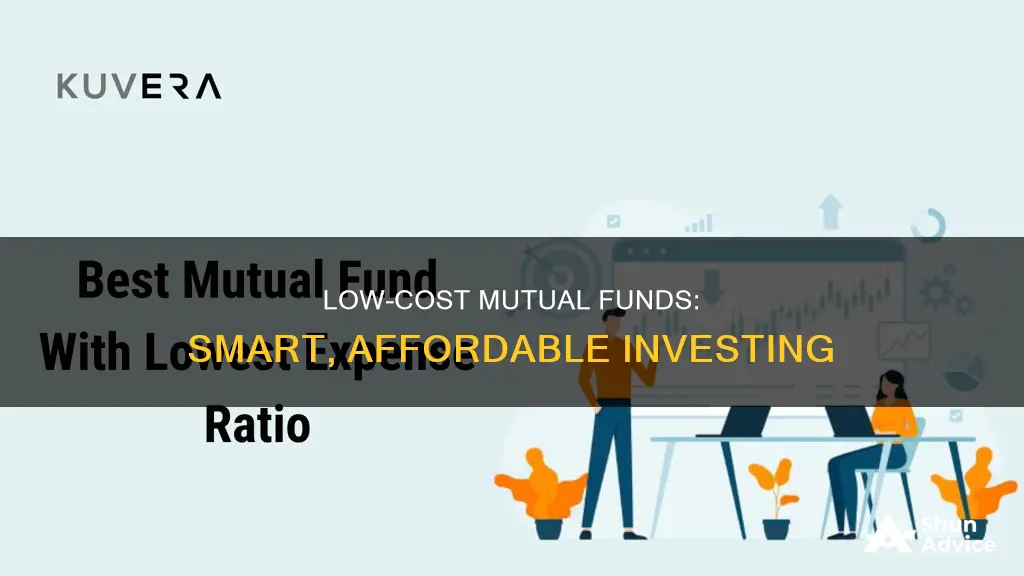
Low-investment mutual funds are a great way for new investors to get started without having to save up hundreds or thousands of dollars. These funds are also known as no-load funds, meaning they don't charge extra fees or sales loads on top of the initial investment. While some funds from Vanguard and Fidelity are highly regarded, they often require a minimum investment in the thousands. However, Charles Schwab offers several funds with no minimum investment, including the Schwab S&P 500 Index (SWPPX) and the Schwab International Core Equity (SICNX). Fidelity also offers four funds with no minimum investment and a 0% expense ratio: Fidelity ZERO Large Cap Index Fund (FNILX), Fidelity ZERO Extended Market Index Fund (FZIPX), Fidelity ZERO Total Market Index Fund (FZROX), and Fidelity ZERO International Index Fund (FZILX). These low-investment mutual funds provide an excellent opportunity for beginners to start building their investment portfolio and benefit from the potential gains of the stock market.
| Characteristics | Values |
|---|---|
| Initial Investment | Low |
| Expense Ratio | Low |
| Sales Load | No |
| Trading Commissions | No |
| Account Service Fees | No |
What You'll Learn

No minimum investment mutual funds
Advantages
- Accessibility: These funds are ideal for beginners who want to start investing with a small amount of money. Removing the minimum investment requirement makes mutual funds more accessible to a wider range of people.
- Diversification: Mutual funds, in general, offer instant diversification by pooling money from multiple investors to purchase a variety of stocks, bonds, or other assets. This diversification helps to reduce risk and can lead to higher returns over time.
- Low Cost: No minimum investment mutual funds often have low expense ratios, which means investors keep more of their returns. Additionally, these funds typically do not charge sales loads or commissions, further reducing costs for investors.
Examples of No Minimum Investment Mutual Funds
Several companies offer no minimum investment mutual funds, including Fidelity and Charles Schwab. Here are some specific examples:
- Fidelity ZERO Large Cap Index Fund (FNILX): This fund seeks to provide investment results corresponding to the total return of a broad range of large-capitalization U.S. companies, with a 0% expense ratio and no minimum investment.
- Fidelity ZERO Extended Market Index Fund (FZIPX): This fund focuses on providing returns from mid- to small-capitalization U.S. companies, again with no minimum investment and a 0% expense ratio.
- Fidelity ZERO Total Market Index Fund (FZROX): This fund aims to provide returns from a broad range of publicly traded companies in the US, with no minimum investment and a 0% expense ratio.
- Fidelity ZERO International Index Fund (FZILX): This fund seeks to provide returns from foreign developed and emerging stocks, offering international diversification with no minimum investment and a 0% expense ratio.
- Charles Schwab S&P 500 Index (SWPPX): This index fund has no minimum initial investment and an ultra-low expense ratio of 0.02%, allowing investors to track the performance of the S&P 500 index.
- Charles Schwab Balanced Fund (SWOBX): A diversified blend of stocks, bonds, and cash, this fund offers a moderate-risk portfolio with no minimum initial investment.
- Charles Schwab International Core Equity (SICNX): For investors looking to include foreign stocks in their portfolio, this fund provides exposure to large-cap stocks outside the United States, with no minimum initial investment.
Factors to Consider
When considering no minimum investment mutual funds, investors should evaluate the same factors as they would for any mutual fund investment:
- Expense Ratio: The expense ratio represents the annual fees charged by the fund, expressed as a percentage of the fund's average net assets. No minimum investment funds typically have low expense ratios, but it's important to compare this factor across different funds.
- Historical Returns: Examining the fund's historical performance over different time periods can provide insight into how it has fared in various market conditions.
- Asset Allocation: Understanding the fund's asset allocation, or how it distributes its investments across different types of assets, sectors, or geographic regions, is crucial for assessing its risk and return potential.
- Investment Strategy: Investors should know whether the fund is passively managed, aiming to mirror a benchmark index, or actively managed, where investment professionals make strategic decisions about the fund's holdings.
Mutual Funds: Investors Seek Diversification and Professional Management
You may want to see also

Low-cost index funds
The first commercially successful index fund was created in 1976 by John Bogle, the founder of Vanguard. Known as the First Index Investment Trust, it tracked the S&P 500. Today, investors can find low-cost index funds in both mutual fund and ETF forms, tracking broad market benchmarks like the Nasdaq-100 index or the MSCI EAFE index, as well as specific sectors like technology or energy.
Index funds are a popular investment choice due to their low fees, broad diversification, and historical performance. They are also more tax-efficient than actively managed funds because of their lower portfolio turnover. However, one disadvantage is their lack of flexibility; since they are designed to mirror a specific market, they decline in value when the market does and cannot pivot to a new strategy.
When choosing an index fund, it is important to consider your investment goals, timeline, and risk tolerance. Compare the expense ratios, tracking errors, and daily trading volumes of different funds that cover the same sector to find the best option for you.
Some examples of low-cost index funds include:
- Vanguard 500 Index Fund Admiral Shares (VFIAX)
- IShares Core U.S. Aggregate Bond ETF (AGG)
- Fidelity Zero Total Market Index Fund (FZROX)
- Vanguard Dividend Appreciation ETF (VIG)
- Invesco Nasdaq 100 ETF (QQQM)
Exchange Funds: Regulated Investment Company Status Explained
You may want to see also

No-load funds
While no-load funds do not charge a sales fee, they do charge operating expenses, such as the expense ratio, which is the percentage of assets under management and covers operating and administrative costs. The largest portion of this fee is to pay for the work of the fund manager and advisor.
Some examples of no-load funds include:
- Schwab S&P 500 Index (SWPPX)
- Schwab Balanced Fund (SWOBX)
- Schwab International Core Equity (SICNX)
- Fidelity ZERO Large Cap Index Fund (FNILX)
- Fidelity ZERO Extended Market Index Fund (FZIPX)
- Fidelity ZERO Total Market Index Fund (FZROX)
- Fidelity ZERO International Index Fund (FZILX)
Target Date Funds: Smart Investment or Limiting Returns?
You may want to see also

Low-cost mutual funds
The most well-known index is the Standard & Poor's 500 (S&P 500), which includes around 500 of the largest publicly traded American companies. Other popular indexes include the Nasdaq Composite, the Dow Jones Industrial Average and the Russell 2000.
When investing in low-cost mutual funds, it's important to consider the index's long-term returns and the cost of owning the fund. Investors should look for the lowest-cost fund that delivers the desired overall investing performance. The expense ratio is a key metric, representing the percentage of an investor's money paid as a fee to the fund company. Lower expense ratios are better for investors, resulting in higher returns on investments.
Sales loads, or commissions, are another cost to watch out for. These can be avoided by investing in no-load funds, which are offered by many fund management companies.
Some examples of low-cost mutual funds include:
- Schwab S&P 500 Index (SWPPX)
- Vanguard Total Stock Market Index Fund (VTSAX)
- Vanguard Value Index Fund Admiral Shares (VVIAX)
- Fidelity ZERO Large Cap Index Fund (FNILX)
- Fidelity ZERO Total Market Index Fund (FZROX)
Additionally, some fund companies, such as Charles Schwab and Fidelity, offer mutual funds with no minimum investment requirements, making them more accessible to beginner investors.
Income or Growth Funds: Which IRA Investment Strategy?
You may want to see also

Mutual funds with no minimums
Mutual funds are an excellent investment option for beginners, but many funds have minimum initial investment amounts of $3,000 or higher. This cost hurdle reduces one of the biggest advantages of investing: getting started early.
However, some companies offer mutual funds with low minimum initial investment amounts or even no minimum investment at all. Here are some examples of mutual funds with no minimum investment:
Fidelity
Fidelity offers several mutual funds with no minimum investment requirements. These include:
- Fidelity ZERO Large Cap Index Fund (FNILX)
- Fidelity ZERO Extended Market Index Fund (FZIPX)
- Fidelity ZERO Total Market Index Fund (FZROX)
- Fidelity ZERO International Index Fund (FZILX)
All of these funds also boast a 0% expense ratio, meaning there are no additional fees associated with investing in these funds. Fidelity also provides 24/7 live customer service and no account fees for retail brokerage accounts.
Charles Schwab
Charles Schwab also offers a few mutual funds with no minimum investment:
- Schwab S&P 500 Index (SWPPX)
- Schwab Balanced Fund (SWOBX)
- Schwab International Core Equity (SICNX)
The Schwab S&P 500 Index fund has a very low expense ratio of 0.02%, while the Schwab Balanced Fund offers a diversified blend of stocks, bonds, and cash, making it a moderate-risk option. The Schwab International Core Equity fund invests in large-cap stocks outside of the United States and has high long-term performance ranks compared to other international funds.
Other Options
In addition to Fidelity and Charles Schwab, there are a few other mutual funds with no minimum investment requirements:
- BlackRock Exchange Portfolio (STSEX)
- Neuberger Berman Small Cap Growth Fund (NSRSX)
The BlackRock Exchange Portfolio has a higher expense ratio of 0.77% but has excellent long-term returns of 14.1% over 15 years and 15.6% over the last 5 years. The Neuberger Berman Small Cap Growth Fund is for investors who are willing to take on more risk and has a five-year annualized gain of 8.5%.
NIIF Master Fund: A Guide to Investing in India's Future
You may want to see also
Frequently asked questions
Low-investment mutual funds are funds that have a low minimum initial investment amount. Some funds have no minimum investment amount at all.
Low-investment mutual funds are a great way for beginner investors to get started without having to save up thousands of dollars. They also allow investors to get started early, which is one of the biggest advantages of investing.
Some examples of low-investment mutual funds include:
- Schwab S&P 500 Index (SWPPX)
- Schwab Balanced Fund (SWOBX)
- Fidelity ZERO Large Cap Index Fund (FNILX)
- Vanguard Total Stock Market Index Fund (VTSAX)
- Vanguard Value Index Fund Admiral Shares (VVIAX)
When choosing a low-investment mutual fund, it's important to consider the fund's long-term returns and the cost to own the fund. Look for funds with low expense ratios and no sales loads.
One potential disadvantage of low-investment mutual funds is that they may have higher fees and capital gains taxes compared to other types of investments. It's important to research and carefully consider the risks before investing.







